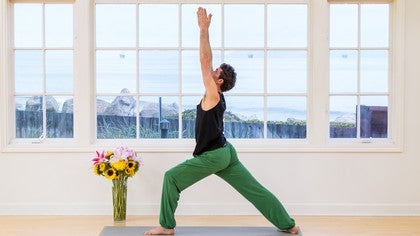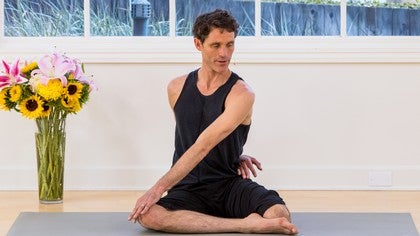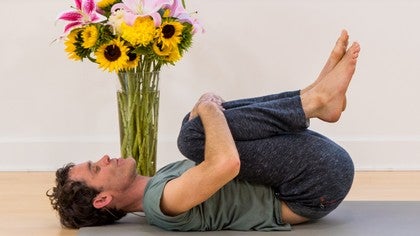Description
About This Video
Transcript
Read Full Transcript
(water rushes) We're gonna do a practice for going to bed. A lot of people suffer from insomnia. It's really one of the most common imbalances that people face, and even if it's not a chronic case of insomnia, every once in a while we find ourselves highly overstimulated. And as we referenced in some of the videos that were Ayurvedic, with Dr. Svoboda and I, it's really good to approach bedtime for like an hour at least, like, you know, turning off the glowing rectangles, which is all the various media devices that we look at that stimulate our eyes, getting yourself into a space where you're really moving into less activity, less talking, less thinking, and just getting into a more sensual and relaxed state. So this is a, this is a sequence that is actually a kind of rhythmic breathing, gentle yoga sequence from your back.
So to begin with, come on to your back with your feet on the ground, as if you were preparing to go into a bridge pose. So you come down, and your heels are about hip width apart, and the heels maybe, you know, four to six inches away from your sit bones, your hands palm down on the ground, arms relaxed, your shoulder blades, your head is relaxed down into the support of the ground. And then, moving your hands so that one of your hands is on your chest and the other hand is on your abdomen, we're gonna our ujjayi breath. What I'd like you to do is feel the sensation of the inhale as it descends all the way down through the chest into the abdomen. (man breathes) And then noticing your exhalation as the exhaled breath ascends up from the abdomen through the chest out the nose.
(man breathes) Two more breaths like that. (man breathes) Each time you exhale, deepen the grounding of your feet, your tailbone, your shoulder blades, your head. One more breath. (man breathes) Then bring your hands down to the ground. And as you inhale, arch your lower spine away from the ground so your pubic bone stretches away from your belly button, your tailbone grounds a little more intensely, and then exhale and curl your tailbone under so your pubic bone comes toward your navel and the small of back rounds.
And then inhale and arch. (man breathes) Exhaling. (man breathes) Gonna take about four or five more breaths this way, gently rocking your pelvis as the small of your back arches away from the ground with your inhale. Feel your feet with your exhalation, grounding the small of your back. Completely relax your shoulders and your jaw and your neck.
(man breathes) You wanna keep your breath rhythm at a really easy length in the sense that you're not having to stress at all to extend your breath, and generally speaking, you start to really be drawn in to focus on the breath simply because of the pleasure and the relaxation that it provides your body and your mind to be focused. (man breathes) One more breath. This kind of rocking is really, really excellent for releasing tension, not only from the joints and the spine, but from the central nervous system, which is really critical to being able to sleep. Then with your next inhale, I'd like you to raise your arms up above your head, in synchronicity with raising your hips into a bridge pose. And at the top of your inhale, the backs of your hands touch and your hips are up, and then as you exhale, you're gonna roll down one vertebrate at a time, hands, breath, and hips all moving in the same rhythm.
Inhale again, you can tuck the tailbone a little bit to curl as you come up into the bridge pose. Really feel your arms stretch out and rest the weight of your arms against the floor at the top of the inhale, and then exhale and synchronize the movement of the arms and the hips back down. Three more like this. Be really kinda gentle, even a little nonchalant about these motions. It's not about trying to stimulate yourself.
It's a lot about just gently pulsing the body a lot, the same way that your heartbeat is constantly pulsing through the body. So when we were in the womb, in our mothers' bellies, we heard our mothers' heartbeats the whole time, and so we have a natural connection to safety, to the womb, to home, to grounding when we take on a rhythmic pattern of breathing and movement, but there's also a quality of being totally at ease, like you were when you were in the safety and the warmth and the grace of your mother's womb. And then exhaling. (man breathes) And coming back down with your hands and your hips. With you next inhalation, gently draw your knees into your chest.
Interlace your fingers over you knees, and then, just with the weight of your arms, don't really necessarily pull you knees in, don't use your arms at all. Just let the weight of your hands rest on your knees, and your knees as you exhale will come closer into your chest. And as you inhale, if you don't hold the knees there as the breath opens with the belly, the knees will come away a little bit. And then as you exhale, relax your shoulders and your throat, feel your knees come back in. Three more breaths like that.
Inhaling still, coming back to feeling the descent of the inhale all the way from the chest to the belly, the ascent of the exhale from the belly out, up through the chest and the throat and the head. Knees coming in closer on the exhale, releasing tension from your low back and your hips. Inhaling. (man breathes) Feel your eyes really soft. You might even let your mouth hang open a little bit, just so there's just no tension at all in the face or the jaw.
(man breathes) And if you can keep your lips sealed and still completely relax your jaw so your teeth come apart inside your moth behind your lips, but you can still do your ujjayi breath. (man breathes) With your next inhalation, bring your feet back down to the ground about four to six inches in front of your sit bones, about hip width. And then stretch your arms out to the side. This is really great for releasing tension from the neck. It's a simple twisting practice.
So with your next exhalation, you're gonna turn your head toward your right hand as your knees soften down to the left. Your left palm comes up, you're gonna ground your right palm. And then as you inhale, slowly bring your knees to center. As you bring the knees up, the arms are turning gradually. As you exhale, the knees begin to lower, your left palm is turning down, your right palm is turning up, and your head is turning opposite of your knees, which in this case is your left.
Keep going like this for four more rounds. Inhale in the center, the hands are turning, the head's turning, the knees are swaying. Exhale, the knees to the left, left palm up, right palm down, head turns to the right. And keep going like this in this really relaxed rhythm, kind of just swaying with the body. This helps to wring out the whole spinal column.
It also helps to improve the circulation in your neck, in your head, which is really important for getting a good night's sleep. You can do this with your eyes closed. (man breathe) Two more. Or, actually, two and a half. Exhale, knees to the right, head to the left, right palm up, left palm down.
And now two more rounds with your eyes closed. Feel the gait of your movement, that's the rhythm of the movement, the smoothness, the smoothness of the movement. And tie that into the pleasure principle. You're moving rhythmically smoothly, but it's as pleasant as it can be, the sensation of the breath descending with the inhale, sensation of the body relaxing as the exhale ascends up from the belly and out through the nose. (man breathes) And this last one is kind of like when you're listening to a song where the last, you know, last verse or the last, you know, chorus starts to actually slow down, so when the song ends, you're at a still point.
So as you come up, feel yourself moving just a little more slowly, as if the movement can stop anywhere in the process. Your throat, your jaw, you eyes, everything completely released. And the next time that you inhale, you bring your knees back to center. And then bring your knees into your chest again. Exhale, relaxing the weight of your arms and your hands onto your shins, so the knees come toward the chest.
And then with your inhale, widen the knees and just take a hold of the outsides of your feet, with the weight of your hands holding the outer foot. And as you exhale, completely relax your elbows and your shoulders, so it's again just the weight of your arms stretching your legs. You're not trying to pull and create any intense stretch sensation. If this is too much to have the feet pointing up toward the ceiling, you can bring the soles of your feet together, and gently part your knees, that's another variation of what we're doing. So whichever variation works for you, you're gonna hold this now for about four more breaths.
Keep your eyes closed. (man breaths) Noticing at the top of your inhale that there's a still point and consciously entering that stillness. Noticing at the bottom of your exhalation the still point, consciously entering the stillness at the end of the exhale. Each inhale, the breath moving down into your pelvis. Each exhale, your breath moving up through the body, relaxing through your pelvis, your back, your abdomen, your shoulders, your throat, your head.
Two more like that. (man breathes) Inhale, pause, completely releasing to that still point just for a few moments. Exhale, relax at the end of the exhale, enter that still point. (man breathes) And then everybody, no matter which position you're in, bringing your feet together, then your knees together. One more time, just gently hugging the knees into your chest.
(man breathes) Then you're gonna roll over to your right side with your left hand in front of your chest. Position your legs in a way that's comfortable for you, and just rest your head on your right arm. Resting on the right side is also one of the ways yogis would encourage their nervous systems to relax. So keep your eyes closed and take three more long, slow breaths here. And noticing the still point at the top of the inhale, at the bottom of the exhale, soothing, relaxing your body, your mind with each breath.
(man breathes) And thank you. Have an excellent night's sleep.
Prana: Robert Svoboda & Scott Blossom
Comments
You need to be a subscriber to post a comment.
Please Log In or Create an Account to start your free trial.
















